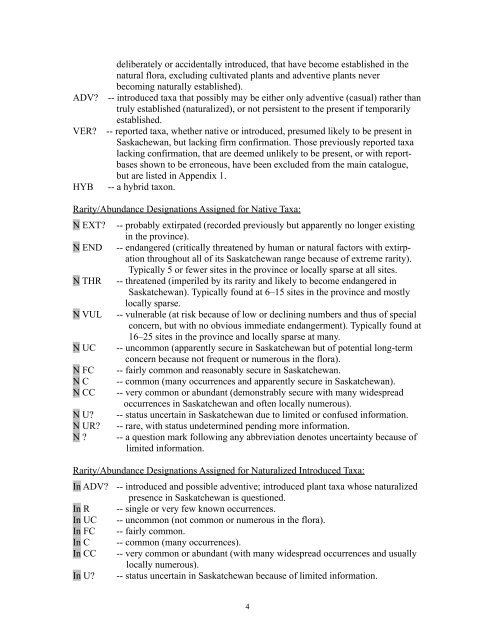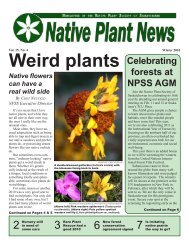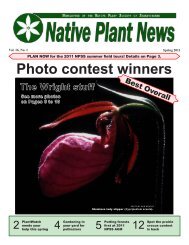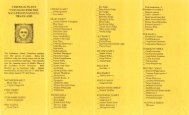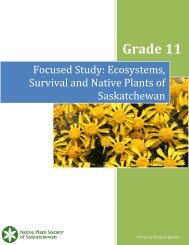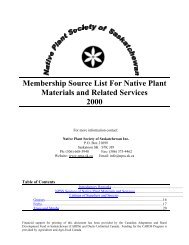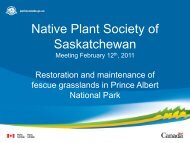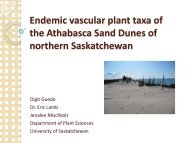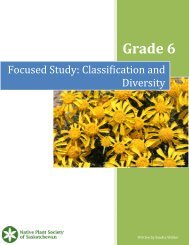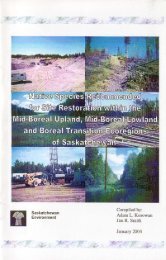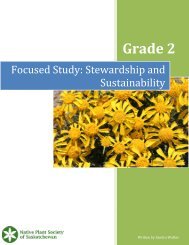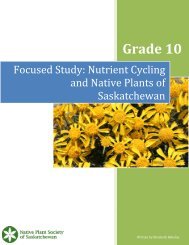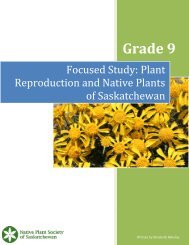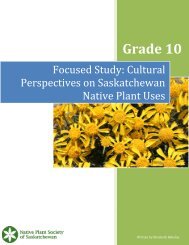Checklist of the Vascular Plants of Saskatchewan - Native Plant ...
Checklist of the Vascular Plants of Saskatchewan - Native Plant ...
Checklist of the Vascular Plants of Saskatchewan - Native Plant ...
Create successful ePaper yourself
Turn your PDF publications into a flip-book with our unique Google optimized e-Paper software.
deliberately or accidentally introduced, that have become established in <strong>the</strong><br />
natural flora, excluding cultivated plants and adventive plants never<br />
becoming naturally established).<br />
ADV? -- introduced taxa that possibly may be ei<strong>the</strong>r only adventive (casual) ra<strong>the</strong>r than<br />
truly established (naturalized), or not persistent to <strong>the</strong> present if temporarily<br />
established.<br />
VER? -- reported taxa, whe<strong>the</strong>r native or introduced, presumed likely to be present in<br />
Saskachewan, but lacking firm confirmation. Those previously reported taxa<br />
lacking confirmation, that are deemed unlikely to be present, or with reportbases<br />
shown to be erroneous, have been excluded from <strong>the</strong> main catalogue,<br />
but are listed in Appendix 1.<br />
HYB -- a hybrid taxon.<br />
Rarity/Abundance Designations Assigned for <strong>Native</strong> Taxa:<br />
N EXT? -- probably extirpated (recorded previously but apparently no longer existing<br />
in <strong>the</strong> province).<br />
N END -- endangered (critically threatened by human or natural factors with extirpation<br />
throughout all <strong>of</strong> its <strong>Saskatchewan</strong> range because <strong>of</strong> extreme rarity).<br />
Typically 5 or fewer sites in <strong>the</strong> province or locally sparse at all sites.<br />
N THR -- threatened (imperiled by its rarity and likely to become endangered in<br />
<strong>Saskatchewan</strong>). Typically found at 6–15 sites in <strong>the</strong> province and mostly<br />
locally sparse.<br />
N VUL -- vulnerable (at risk because <strong>of</strong> low or declining numbers and thus <strong>of</strong> special<br />
concern, but with no obvious immediate endangerment). Typically found at<br />
16–25 sites in <strong>the</strong> province and locally sparse at many.<br />
N UC -- uncommon (apparently secure in <strong>Saskatchewan</strong> but <strong>of</strong> potential long-term<br />
concern because not frequent or numerous in <strong>the</strong> flora).<br />
N FC -- fairly common and reasonably secure in <strong>Saskatchewan</strong>.<br />
N C -- common (many occurrences and apparently secure in <strong>Saskatchewan</strong>).<br />
N CC -- very common or abundant (demonstrably secure with many widespread<br />
occurrences in <strong>Saskatchewan</strong> and <strong>of</strong>ten locally numerous).<br />
N U? -- status uncertain in <strong>Saskatchewan</strong> due to limited or confused information.<br />
N UR? -- rare, with status undetermined pending more information.<br />
N ? -- a question mark following any abbreviation denotes uncertainty because <strong>of</strong><br />
limited information.<br />
Rarity/Abundance Designations Assigned for Naturalized Introduced Taxa:<br />
In ADV? -- introduced and possible adventive; introduced plant taxa whose naturalized<br />
presence in <strong>Saskatchewan</strong> is questioned.<br />
In R -- single or very few known occurrences.<br />
In UC -- uncommon (not common or numerous in <strong>the</strong> flora).<br />
In FC -- fairly common.<br />
In C -- common (many occurrences).<br />
In CC -- very common or abundant (with many widespread occurrences and usually<br />
locally numerous).<br />
In U? -- status uncertain in <strong>Saskatchewan</strong> because <strong>of</strong> limited information.<br />
4


